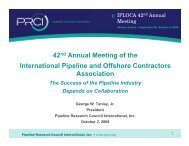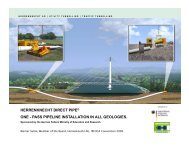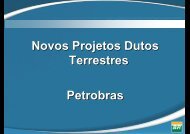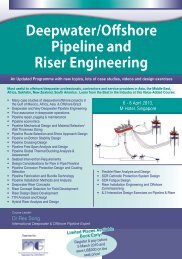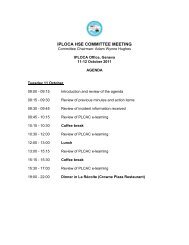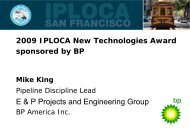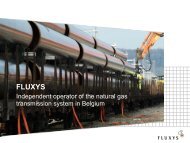EPRG-PRCI-APIA 17th JOINT TECHNICAL MEETING ON ... - Iploca
EPRG-PRCI-APIA 17th JOINT TECHNICAL MEETING ON ... - Iploca
EPRG-PRCI-APIA 17th JOINT TECHNICAL MEETING ON ... - Iploca
You also want an ePaper? Increase the reach of your titles
YUMPU automatically turns print PDFs into web optimized ePapers that Google loves.
<strong>APIA</strong> Project 1.2.9: Measurement Uncertainty in Hydrostatic Leak Tests<br />
Usually the largest contributor to pressure change during a leak test is the change in<br />
temperature. The averaging of infrequent and uncertain measurements affects the<br />
assessment of whether a test section contains a leak or otherwise. This uncertainty limits<br />
the maximum volume of a test section; either the test section length must be reduced, or the<br />
duration of the leak test increased.<br />
The purpose of the project is to develop an appreciation of each measurement uncertainty<br />
and to establish a methodology where these components can be combined to enable better<br />
design of each test section for hydrostatic leak test. The data will be used to fill knowledge<br />
gaps in base data required for AS 2885.5 – Field Hydrostatic testing<br />
.<br />
<strong>EPRG</strong> Project 144, JTM Paper 15: Extension of the <strong>EPRG</strong> guidelines for assessing<br />
girth weld defects<br />
Guidelines for assessing defects in girth welds were published by <strong>EPRG</strong> in 1996. They<br />
contained a number of restrictions on their application; in particular, the through-wall depth of<br />
a defect was assumed not to exceed 3 mm, wall thickness was restricted to between 7 mm<br />
and 25 mm, and the material strength was restricted to X70 or below.<br />
Recently-completed work by <strong>EPRG</strong> now supports extension of the guidelines up to X80<br />
grade material. Using a reference stress (collapse) analysis, through-wall depths of 5 mm<br />
can be allowed so long as the defect length is reduced, and the same approach can be used<br />
to extend the range of allowable wall thickness. A simple approach based on elastic stress<br />
concentration has been used to relate allowable misalignment to the applied stress.<br />
See also in the JTM Programme booklet:<br />
Paper 16: An alternative to the pre-service hydrotest<br />
Workshop 5: Mechanical damage<br />
<strong>PRCI</strong> Project MD-1-1: Dual-field MFL inspection technology to detect and Characterize<br />
mechanical damage<br />
This project will establish the capability of dual-field MFL technology to detect mechanical<br />
damage and discriminate between critical and benign anomalies. A tool will be bukilt and<br />
tested in an operating pipeline. It is expected that dual-field MFL technology will significantly<br />
reduce the number of false positive indications (thus reducing needless digs) and false<br />
negative indications (significant anomalies that are missed)<br />
<strong>PRCI</strong> Project MD-1-2, JTM Paper 28: Performance characteristics of current ILI<br />
technologies for mechanical damage detection<br />
This project collates and evaluates field ILI data to determine the ability of different current<br />
MFL technologies to detect, characterize and size various types of mechanical damage in<br />
pipelines, with a view to providing performance measures and guidance for using existing ILI<br />
technology to find and assess mechanical damage.<br />
<strong>PRCI</strong> Project MD-1-3: Understanding MFL signals from mechanical damage<br />
This ongoing work is developing an improved fundamental understanding of magnetic flux<br />
signals emanating from damaged pipe, including the separate effects of shape change,<br />
elastic and plastic deformation, to enable better identification of the features found during<br />
field runs.<br />
<strong>PRCI</strong> Project MD-1-6: Ultrasonic measurements of strains in pipelines<br />
The project aims to evaluate and demonstrate the vfield capability of a hand-held device<br />
designed to measure local strains in distorted or damaged pipe. Initial work will focus on<br />
specifying the measurement requirements and device performance, and evaluation of<br />
prototype instruments



